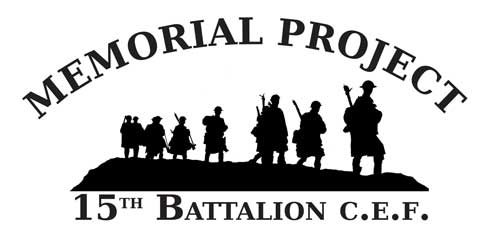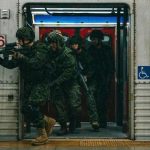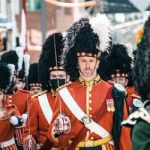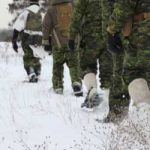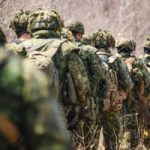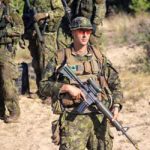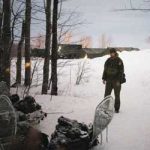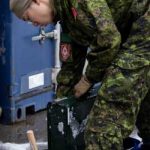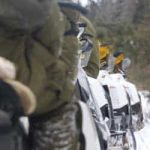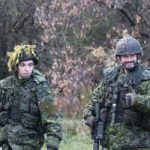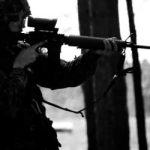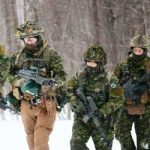Today is the 106th anniversary – to the exact day – of the gas attack against the Canadians during the 2nd battle of Ypres on April 24, 1915. It was Canada’s and the 15th Battalion (48th Highlanders) first major engagement of The Great War – it was to be their ‘Baptism of Fire’.
Their desperate but determined defence of the Ypres salient, in the face of the mass use of poison chlorine gas, against numerically superior German forces would win for Canada, and for the battalions who fought there, a reputation for toughness and reliability under fire. It was the birth of an identity and a spirit that would come to full fruition at Vimy and in the battles of the 100 Days. Positioned at the hinge apex of the Canadian front line and bearing the brunt of the concentrated gas without artillery fire to support them, the 15th Battalion suffered the highest single day casualties of any Canadian unit in WW1. The battalion was effectively destroyed. Its Officer and Senior NCO leadership was decimated. That it recovered, rebuilt and went on to take part in every major Canadian engagement of the war was in no small part due to the determination to maintain its Regimental identity despite near annihilation on the battlefield and the non-regimental reinforcement system employed by the Canadian Expeditionary Force following Ypres and maintained throughout the war.
The Regiment, as a military formation, did not fight in the Great War 1914-1918. The Regiment did however raise three battalions and men for numerous drafts to other battalions that went to become part of the CEF. All three of the battalions raised by the Regiment – 15th, 92nd and 134th – maintained strong regimental identity – their uniforms, kilts, insignia and Pipe Bands were all distinctively 48th. The 15th Battalion, which was the only one of the three to see service at the front, even had the distinction of having their CEF numerical designation officially annotated – 15thBattalion (48th Highlanders) in recognition of the battalion’s connection to the 48th which had supplied most of its original men. Few CEF battalions were accorded that distinction.
The ability to maintain that unique regimental identity, even in the earliest days of the war is impressive when you consider that even the original 812 men that left Toronto in September 1914 were not all from the 48th and the 350 more who were added at Valcartier to bring the battalion up to full war strength (1152) were from other Militia Regiments with their own regimental identities.
Preserving the 48th identity from the outset and sustaining it throughout the war did not happen without the dedicated effort of the home regiment to keep its battalions equipped with all the visible regimental identifiers such as kilts, insignia, badges, etc, and the work of the 15th Battalion’s leadership in the field to insure that new men were welcomed into the unit and instilled with the spirit of their new battalion and its identity. Again, an impressive feat when you consider that three of the battalion’s five Commanding Officers had no pre-war connection to the 48th at all.
So the 15th Battalion that arrived in Ypres on the 19th of April was very much a unit with a strong 48th identity – whether by origin or adoption. But at 2nd Ypres that battalion was effectively destroyed in the valley of the Stroombeek, on Gravenstafel ridge and in the outskirts St Julien. Of the 912 men that went into the field, 647 would become casualties; 233 dead of which the remains of 187 would never be recovered; and 248 became POWs;
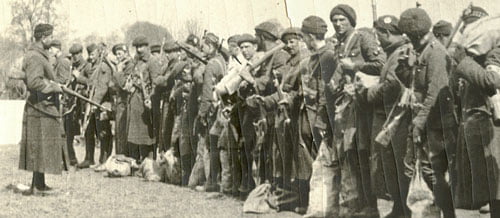
The battalion that answered the roll in Wieltje on the evening of April 25th – 106 years ago tomorrow night – was 3 officers and 150 men. But to paraphrase the ancient Greek poet Sophocles “you can kill men but you cannot kill an idea (spirit)”. Within mere days reinforcements were rushed to Belgium from units in the UK to rebuild the shattered Canadian units – by early May the 15th Battalion’s strength was 650.
The combination of the severe casualties and the influx of large numbers of reinforcements from units with other regimental affiliations could have easily resulted in the end of the 15th’s unique identity. In fact, this was an ongoing possibility for the remainder of the war with the steady number of casualties being replaced by men from other battalions.
By 1918 over 7000 men, the majority from over 70 units with no connection to the 48th, had served with the 15thBattalion. The November 1918 Nominal Roll showed that less than 100 of the ‘originals’ remained. Yet throughout the war identity and spirit never waned and the battalion that marched across the Rhine in 1919 under the Colours of the Regiment, sent over to them for the occasion, looked every bit as 48th as the one that had departed Toronto four years before.
How was regimental identity and spirit maintained?
From the outset the Regiment back in Toronto worked to insure identity was preserved The supply of kilts, uniform items and regimental insignia was maintained to all three battalions – again especially to the 15th at the front and even to the 15th men in German POW camps. Although the 15th was part of the CEF chain of command, strong lines of communication were maintained to the parent Regiment back in Toronto on a wide variety of issues not the least of which was assisting families of those serving, the wounded, the POWs and of course, the Fallen. I would suggest that these types of tasks are not unfamiliar to serving and former members during all the conflicts that followed The Great War – most recently Afghanistan.
A great deal of the regiment’s identity would come from its participation in the Great War – its first major conflict and one on a scale of ferocity that no one could have foreseen. Some of that Regimental identity can be seen in the Officer’s Mess where the portraits of three Officers who commanded the 15th Battalion – Cols Currie, Bent and Marshall are prominently displayed; The Regimental Colours, arguably the most hallowed of all Regimental artifacts are also displayed prominently in the Mess and bear 10 of the 21 Battle Honours won by the 15th Battalion – the very first battle honours awarded to the Regiment. The Regimental Colour bears the names of battles familiar to most Canadians – names that are part of our national identity and most certainly part of our Regimental identity – Passchendaele, Mt Sorrel, the Somme, Vimy and of course, Ypres. That Great War identity is present outside the walls of the messes – the Regimental memorial at Queen’s Park was dedicated in 1923 to all who served, especially those that fell in 1914-18 war; it is present in the Battle Honours on drums of the of Pipe Band and the Drum Major’s baldric; it is present in the khaki balmorals adopted by the 15th Battalion in the trenches and worn ever since to the present day.
So all this to say, that the identity and spirit that bond the members of a Regiment together is not something one simply acquires by joining up and it should never be taken for granted – despite the powerful hold it has on us. It transcends bricks and mortar and as what happened at 2nd Ypres shows us, it transcends the very men and women who make it up at any point in time. Whether it faces destruction in war or the perils of peacetime apathy and frequent government disinterest, regimental identity and spirit needs to be constantly nurtured; it needs to constantly balance and blend the preservation of time honoured traditions with evolving realities – respecting the past but recognizing the present and the future. Regimental leadership is essential in this as it was in the Great War, it has an obligation to preserve identity and spirit and to embrace all who adopt it as their own. Good regiments, like the 48th, have worked very hard at doing all that. So it was in The Great War, so it must be today.
Brigadier General (ret)
Greg Young OMM, MSM, CD
Chairman
15th Battalion CEF Memorial Project



